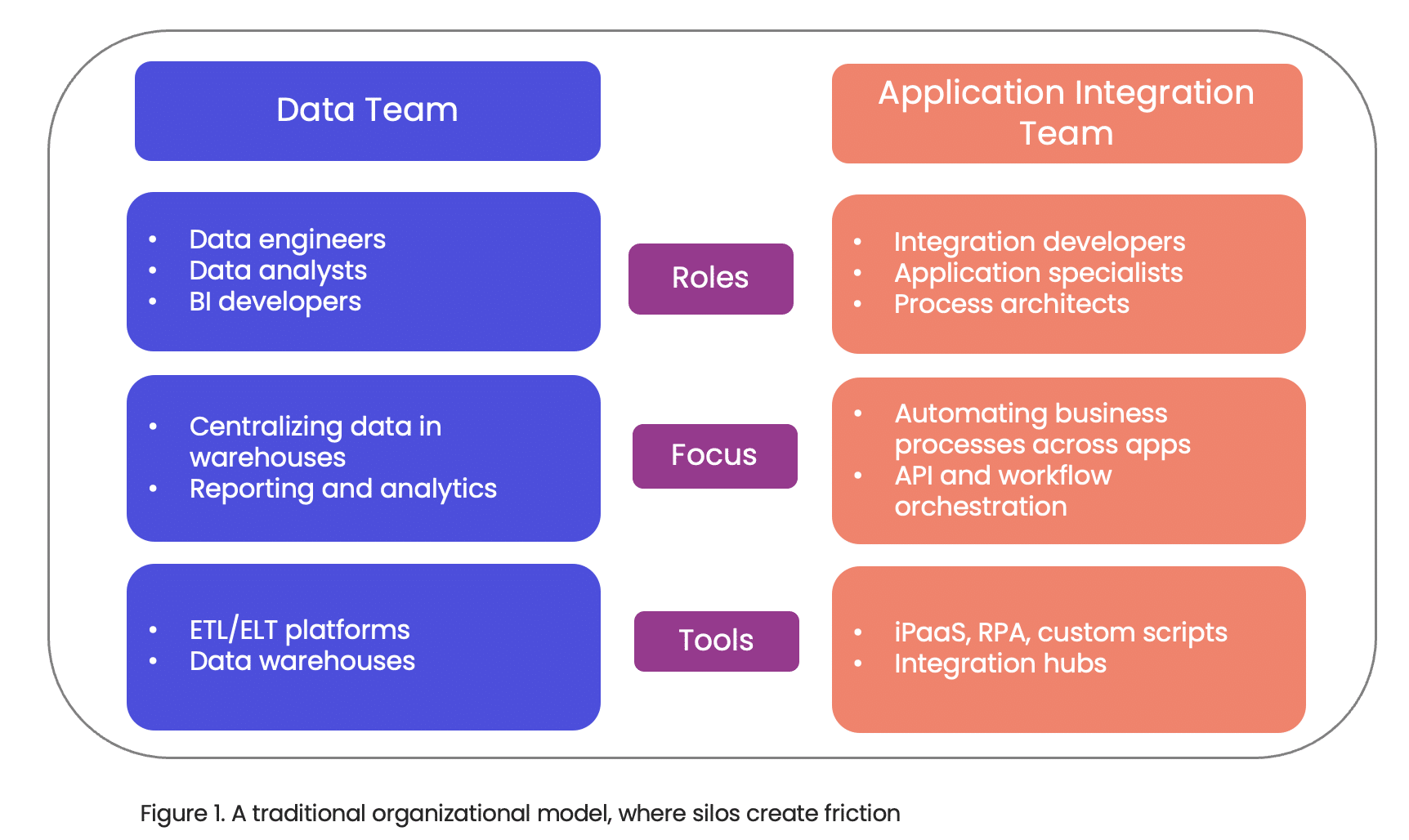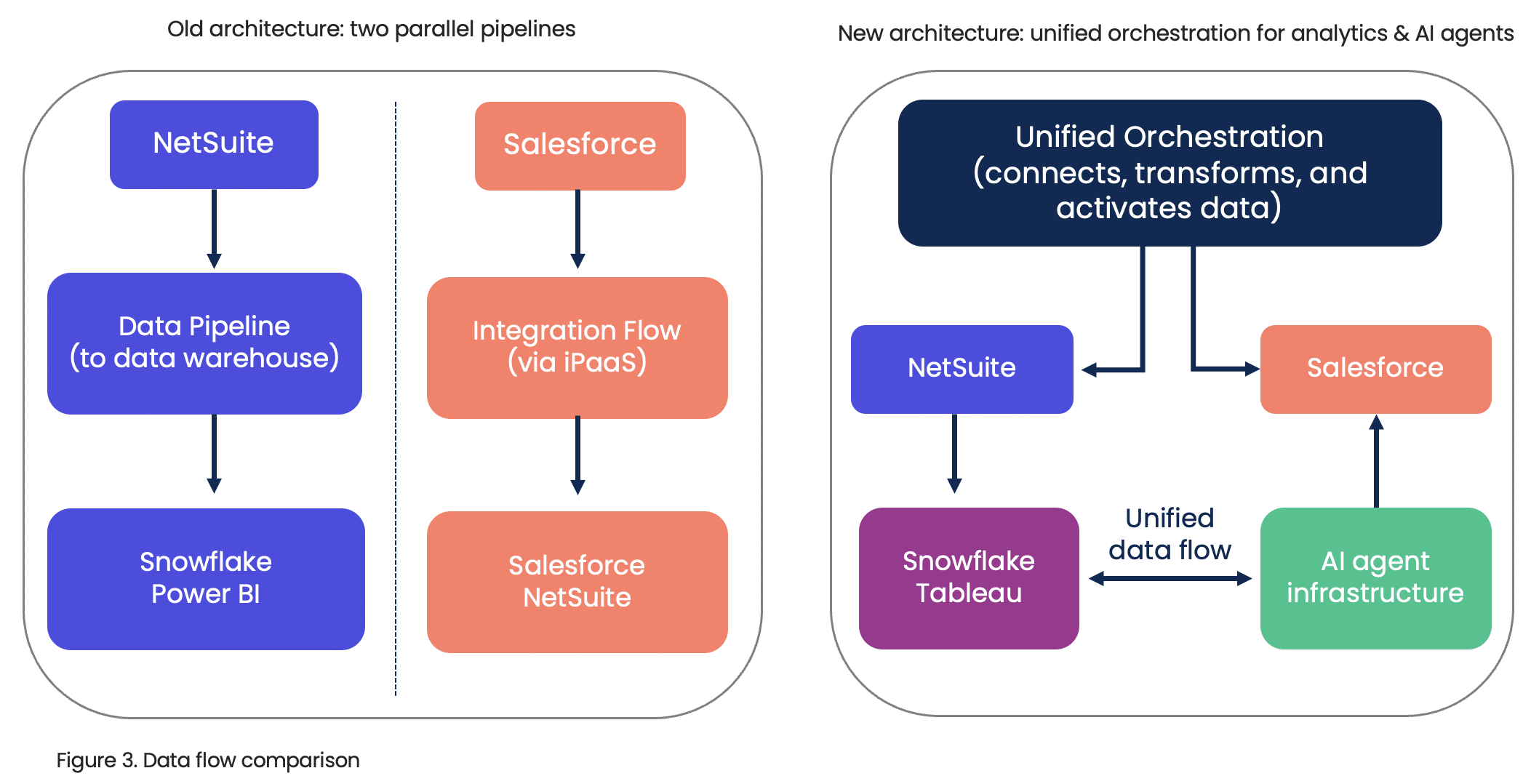For years, enterprise data and application integration strategies have run on parallel tracks, each with its own team, tools, and goals. On one side, data teams — composed of data engineers and analysts — focus on building pipelines to centralize and prepare data for analytics. On the other side, application integration teams are tasked with enabling business process automation through application-to-application integration.
But with the emergence of Agentic AI — AI that can autonomously take action, make decisions, and automate workflows across systems — these traditionally siloed functions can no longer afford to operate in isolation. To be successful in this era of agentic transformation, businesses will need both high data quality and the combined business context provided by data engineers and analysts.
The opportunity ahead is bigger than more efficient analytics or streamlined process automation. It’s about unlocking intelligent, proactive systems that can drive real business outcomes. And to get there, organizations must rethink how their data and integration teams are structured.
The Historical Divide: Data Teams vs. Integration Teams
Traditionally, data and application integration teams have had clearly defined, very separated roles:
Data Teams: Responsible for building pipelines that move large volumes of data from operational systems (like NetSuite) into centralized platforms (like Snowflake), where it can be analyzed via tools like Power BI or Tableau. Their goal is to enable better decision-making through analytics and reporting.
Application Integration Teams: Focused on enabling operational efficiency by connecting apps such as NetSuite and Salesforce to each other and to other apps. These integrations typically involve transactional or event-driven data, supporting real-time business processes like order-to-cash or lead-to-invoice.
Despite overlapping data sources and similar architectural needs, these two groups rarely collaborate in a meaningful way.
The Rise of Agentic AI Demands a New Operating Model
AI agents are fundamentally changing how businesses think about automation. Unlike traditional systems that require pre-defined rules and triggers, AI agents can dynamically interpret context, reason across data, and take autonomous actions.
But to operate effectively, these agents need two critical inputs:
- Access to reliable, contextualized data (which lives in the domain of data teams)
- Understanding of business processes and workflows (which lives in the application integration team)
Today, data teams are being asked to support AI initiatives by building pipelines that deliver relevant data to AI agents. At the same time, integration teams understand the processes those agents need to automate, but aren’t always equipped to deliver the data context AI requires. This fragmentation leads to slower implementation, misaligned strategies, and duplicated effort.
If this is all sounding familiar, that’s because about 15 years ago, businesses came to a strikingly similar realization about software developers and IT operations. That’s how DevOps was born.
Why It’s Time to Bring These Teams Together
The benefits of unifying data and application integration teams — or at least creating a structure in which people with each of these roles are working collaboratively — are also a lot like the benefits so many organizations have realized from DevOps.
1. Accelerated Intelligent Automation
By aligning the teams closest to the data (data engineering) and the processes (integration specialists), organizations can more quickly design and deploy AI-driven automations that are both data-rich and context-aware.
2. Increased Data Activation Across the Business
Data doesn’t just support dashboards anymore. It powers decisions and triggers workflows. A unified team ensures that pipelines are not just delivering data for analytics, but activating it across tools, workflows, and AI agents.
3. Resource Optimization and Reduced Operational Complexity
Siloed teams inevitably result in duplication of effort and often of systems as well. Creating a combined team can consolidate tooling, reduce redundancy, and streamline support models to save time, costs, and human capital.
4. Simplified Technology Stack and Governance
When data and integration initiatives are aligned, organizations can rationalize their tech stack and reduce tool sprawl. This also makes it easier to implement consistent governance, observability, and security practices.
5. Better Alignment With Business Outcomes
Application integration teams have deep domain expertise in business processes; data teams have deep technical expertise in data flow. Combining the two creates a structure that’s closer to the business, more agile, and better able to translate goals into solutions.
The result: One cross-functional team that delivers data pipelines, AI agent support, and app-to-app automation with less duplication, faster delivery, and shared governance.
Looking Ahead: From Siloed Execution to Unified Intelligence
Some organizations are already moving toward a “data integration and automation team” model, which merges responsibilities across the data pipeline, application integration, and automation spectrum. This team may:
- Use modern platforms that support both application and data integration
- Build reusable connectors and pipelines that serve multiple use cases
- Work in cross-functional pods with business stakeholders to drive AI agent use cases
- Align under a single leader (e.g. a head of data and integration or VP of automation)
As the AI landscape continues to evolve, organizational structure needs to evolve with it. The old model of dividing data engineering from application integration is increasingly a barrier to agile business operations.
By bringing these capabilities together, companies position themselves to move faster, operate smarter, and unlock the true potential of agentic AI. The future of integration isn’t just about connecting systems — it’s about orchestrating intelligence across them.
Contact us to find out how Boomi can help you accelerate innovation, lower costs, and enhance security with integration, API management, data management, and AI agent management all in one unified platform.


 English
English 日本語
日本語


